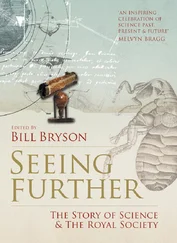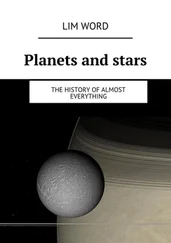Now the first thing you are likely to realize is that space is extremely well named and rather dismayingly uneventful. Our solar system may be the liveliest thing for trillions of miles, but all the visible stuff in it-the Sun, the planets and their moons, the billion or so tumbling rocks of the asteroid belt, comets, and other miscellaneous drifting detritus-fills less than a trillionth of the available space. You also quickly realize that none of the maps you have ever seen of the solar system were remotely drawn to scale. Most schoolroom charts show the planets coming one after the other at neighborly intervals-the outer giants actually cast shadows over each other in many illustrations-but this is a necessary deceit to get them all on the same piece of paper. Neptune in reality isn’t just a little bit beyond Jupiter, it’s way beyond Jupiter-five times farther from Jupiter than Jupiter is from us, so far out that it receives only 3 percent as much sunlight as Jupiter.
Such are the distances, in fact, that it isn’t possible, in any practical terms, to draw the solar system to scale. Even if you added lots of fold-out pages to your textbooks or used a really long sheet of poster paper, you wouldn’t come close. On a diagram of the solar system to scale, with Earth reduced to about the diameter of a pea, Jupiter would be over a thousand feet away and Pluto would be a mile and a half distant (and about the size of a bacterium, so you wouldn’t be able to see it anyway). On the same scale, Proxima Centauri, our nearest star, would be almost ten thousand miles away. Even if you shrank down everything so that Jupiter was as small as the period at the end of this sentence, and Pluto was no bigger than a molecule, Pluto would still be over thirty-five feet away.
So the solar system is really quite enormous. By the time we reach Pluto, we have come so far that the Sun-our dear, warm, skin-tanning, life-giving Sun-has shrunk to the size of a pinhead. It is little more than a bright star. In such a lonely void you can begin to understand how even the most significant objects-Pluto’s moon, for example-have escaped attention. In this respect, Pluto has hardly been alone. Until the Voyager expeditions, Neptune was thought to have two moons; Voyager found six more. When I was a boy, the solar system was thought to contain thirty moons. The total now is “at least ninety,” about a third of which have been found in just the last ten years.
The point to remember, of course, is that when considering the universe at large we don’t actually know what is in our own solar system.
Now the other thing you will notice as we speed past Pluto is that we are speeding past Pluto. If you check your itinerary, you will see that this is a trip to the edge of our solar system, and I’m afraid we’re not there yet. Pluto may be the last object marked on schoolroom charts, but the system doesn’t end there. In fact, it isn’t even close to ending there. We won’t get to the solar system’s edge until we have passed through the Oort cloud, a vast celestial realm of drifting comets, and we won’t reach the Oort cloud for another-I’m so sorry about this-ten thousand years. Far from marking the outer edge of the solar system, as those schoolroom maps so cavalierly imply, Pluto is barely one-fifty-thousandth of the way.
Of course we have no prospect of such a journey. A trip of 240,000 miles to the Moon still represents a very big undertaking for us. A manned mission to Mars, called for by the first President Bush in a moment of passing giddiness, was quietly dropped when someone worked out that it would cost $450 billion and probably result in the deaths of all the crew (their DNA torn to tatters by high-energy solar particles from which they could not be shielded).
Based on what we know now and can reasonably imagine, there is absolutely no prospect that any human being will ever visit the edge of our own solar system-ever. It is just too far. As it is, even with the Hubble telescope, we can’t see even into the Oort cloud, so we don’t actually know that it is there. Its existence is probable but entirely hypothetical. [2]
About all that can be said with confidence about the Oort cloud is that it starts somewhere beyond Pluto and stretches some two light-years out into the cosmos. The basic unit of measure in the solar system is the Astronomical Unit, or AU, representing the distance from the Sun to the Earth. Pluto is about forty AUs from us, the heart of the Oort cloud about fifty thousand. In a word, it is remote.
But let’s pretend again that we have made it to the Oort cloud. The first thing you might notice is how very peaceful it is out here. We’re a long way from anywhere now-so far from our own Sun that it’s not even the brightest star in the sky. It is a remarkable thought that that distant tiny twinkle has enough gravity to hold all these comets in orbit. It’s not a very strong bond, so the comets drift in a stately manner, moving at only about 220 miles an hour. From time to time some of these lonely comets are nudged out of their normal orbit by some slight gravitational perturbation-a passing star perhaps. Sometimes they are ejected into the emptiness of space, never to be seen again, but sometimes they fall into a long orbit around the Sun. About three or four of these a year, known as long-period comets, pass through the inner solar system. Just occasionally these stray visitors smack into something solid, like Earth. That’s why we’ve come out here now-because the comet we have come to see has just begun a long fall toward the center of the solar system. It is headed for, of all places, Manson, Iowa. It is going to take a long time to get there-three or four million years at least-so we’ll leave it for now, and return to it much later in the story.
So that’s your solar system. And what else is out there, beyond the solar system? Well, nothing and a great deal, depending on how you look at it.
In the short term, it’s nothing. The most perfect vacuum ever created by humans is not as empty as the emptiness of interstellar space. And there is a great deal of this nothingness until you get to the next bit of something. Our nearest neighbor in the cosmos, Proxima Centauri, which is part of the three-star cluster known as Alpha Centauri, is 4.3 light-years away, a sissy skip in galactic terms, but that is still a hundred million times farther than a trip to the Moon. To reach it by spaceship would take at least twenty-five thousand years, and even if you made the trip you still wouldn’t be anywhere except at a lonely clutch of stars in the middle of a vast nowhere. To reach the next landmark of consequence, Sirius, would involve another 4.6 light-years of travel. And so it would go if you tried to star-hop your way across the cosmos. Just reaching the center of our own galaxy would take far longer than we have existed as beings.
Space, let me repeat, is enormous. The average distance between stars out there is 20 million million miles. Even at speeds approaching those of light, these are fantastically challenging distances for any traveling individual. Of course, it is possible that alien beings travel billions of miles to amuse themselves by planting crop circles in Wiltshire or frightening the daylights out of some poor guy in a pickup truck on a lonely road in Arizona (they must have teenagers, after all), but it does seem unlikely.
Still, statistically the probability that there are other thinking beings out there is good. Nobody knows how many stars there are in the Milky Way-estimates range from 100 billion or so to perhaps 400 billion-and the Milky Way is just one of 140 billion or so other galaxies, many of them even larger than ours. In the 1960s, a professor at Cornell named Frank Drake, excited by such whopping numbers, worked out a famous equation designed to calculate the chances of advanced life in the cosmos based on a series of diminishing probabilities.
Читать дальше












